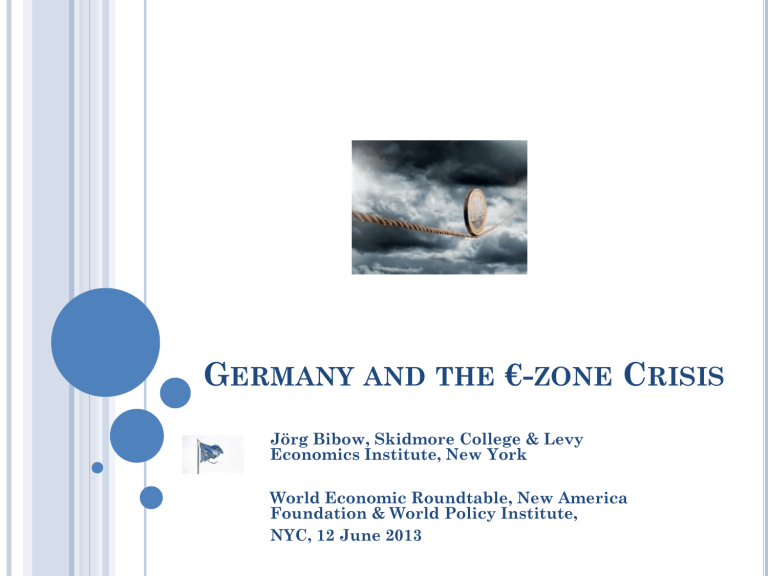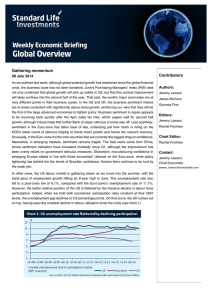The Euroland Crisis and Germany`s Euro Trilemma
advertisement

GERMANY AND THE €-ZONE CRISIS Jörg Bibow, Skidmore College & Levy Economics Institute, New York World Economic Roundtable, New America Foundation & World Policy Institute, NYC, 12 June 2013 AIM & MESSAGE MESSAGE: Having misinterpreted its own economic history, Germany is forcing an unworkable policy regime upon Euro-zone Posing great risk to global recovery Germany blind to its own vulnerability J Bibow: Germany & Euro-zone Crisis, NYC, 12 June 13 AIM: Explore Germany’s central role in the ongoing Euro-zone crisis 2 STRUCTURE OF TALK 1. 3. 4. 5. 6. 7. J Bibow: Germany & Euro-zone Crisis, NYC, 12 June 13 2. The “German model” The trouble with exporting the German model The key causes behind Euro-zone crisis Unimpressive pre-crisis performance Crisis (mis-)management Conditions for proper crisis resolution Concluding remarks 3 1. THE GERMAN MODEL “price stability above all else” Independent Buba as referee: to check labor unions and fiscal policy COMPETITIVENESS DISCIPLINE Asymmetric MP; no job in stimulating demand Relying on export engine worked for Germany because and as long as others behaved differently Easier to balance budget alongside external surplus J Bibow: Germany & Euro-zone Crisis, NYC, 12 June 13 Lower inflation actually caused growth in Germany in environments of fixed nominal exchange rates 4 A HISTORY OF EXTERNAL SURPLUSES J Bibow: Germany & Euro-zone Crisis, NYC, 12 June 13 5 2. THE TROUBLE WITH EXPORTING IT Maastricht meant export of Germany model Some temporary factors in 1990s + Interest-rate convergence, “new economy” boom - “burden” of German unification (“transfer union”) So Germany became “sick man of the euro” German response: more wage repression, fiscal austerity, and structural labor market reforms J Bibow: Germany & Euro-zone Crisis, NYC, 12 June 13 Meant trouble for Germany because key trade partners now required to be like Germany 6 MIRACULOUS HEALING OF THE SICK MAN GDP G GDP euro unemployment G unemployment euro 14 percent change // in percent 10 8 6 4 2 0 1995 1996 1997 1998 1999 2000 2001 2002 2003 2004 2005 2006 2007 2008 2009 2010 2011 2012 2013 -2 J Bibow: Germany & Euro-zone Crisis, NYC, 12 June 13 12 -4 -6 Source. IMF World Economic Outlook database (April 2013) Notes. real GDP annual growth rates, unemployment rates 7 3. KEY CAUSES BEHIND €-ZONE CRISIS Deep cause: regime flaws 1) 3) More immediate cause: German misbehavior How wage repression, structural reform, & mindless austerity in Germany undermined currency union J Bibow: Germany & Euro-zone Crisis, NYC, 12 June 13 2) Cutting the Treasury-CB nexus of sovereign states Nobody “minding the store” No proper policy coordination to ensure convergence and cohesion of union 8 1) TREASURY-CB NEXUS RATHER VITAL Treasury-CB nexus vital to safeguard liquidity and solvency of banking system Euro decoupled member states’ national CB and national Treasury, while ECB not meant to be LOLR and Euro Treasury nonexistent Strength! Says German model of central banking CB independence “above all else” (Buba as referee) Hyper-fears of “fiscal dominance” (Weimar, MEFOs) J Bibow: Germany & Euro-zone Crisis, NYC, 12 June 13 National treasury strengthened by national CB underwriting of financial system liquidity, just as CB strengthened by Treasury’s “deep pockets” 9 2) NOBODY “MINDING THE STORE” No demand management foreseen in good times “Stability-oriented” monetary policy asymmetric “Disciplined” fiscal policy asymmetric too “Below 3%”: deficits can be “excessive” but never too small Policy mix? No, as coordination threatens CBI! “Below 2%”: Quick to hike, slow to ease = anti-growth bias Fiscal stance random, macro policy mix set by ECB No LOLR foreseen in bad times “Market-policy domain problem”: common market but no common policy = fragility, as markets “off the leash” and without backstop Today: Common financial market without “banking union” J Bibow: Germany & Euro-zone Crisis, NYC, 12 June 13 10 3) CONVERGENCE NOT ENSURED Euro-zone members commit to common inflation rate “Golden rule of currency union”: National ULC trends must be aligned with common inflation norm As nominal exchange rates eliminated, relative ULC trends determine intra-area competitiveness positions While € determines extra-area competitiveness Diverging national ULC trends undermine union Divergences cumulative, lastingly distort competitiveness positions, causing current account imbalances And persistent CA imbalances involve debt buildups J Bibow: Germany & Euro-zone Crisis, NYC, 12 June 13 ECB: “below but close to 2%” 11 4. UNIMPRESSIVE PRE-CRISIS PERFORMANCE Business cycle Brief booms, long (domestic demand) stagnations Remarkably export-dependent for large economy Growth and policy outcomes Declining trend growth rate HICP (headline) inflation mostly above 2% Budget deficits mostly above 3% J Bibow: Germany & Euro-zone Crisis, NYC, 12 June 13 Buildup of massive divergences and imbalances 12 NOTORIOUS GROWTH LAGGARD Lack of domestic demand management Persistent high unemployment Budget pressures, so SGP provokes tax hikes While ECB thinks it is not responsible Alas, MP and FP shoot each other in the foot! Both missed their magic numbers! Official blame on “structural problems” Hence “structural reform” as panacea Strangely, Germany never had a problem growing on strong export stimuli J Bibow: Germany & Euro-zone Crisis, NYC, 12 June 13 13 LOW GROWTH AND “TAX-PUSH INFLATION” J Bibow: Germany & Euro-zone Crisis, NYC, 12 June 13 14 DIVERGENCE! EUROPE CONVERGES TO GERMANY’S HISTORICAL STABILITY NORM BY MID ‘90S (West) Germany Austria Netherlands Italy Spain historical NORM France 18 1980s 1990s 2000s 14 12 in percent 10 8 6 4 2 J Bibow: Germany & Euro-zone Crisis, NYC, 12 June 13 16 0 -2 -4 Source. AMECO, Destatis Note. Nominal unit labor costs, total economy 15 BUT GERMANY ITSELF DIVERGES OFFICIALLY, everybody ‘lost competitiveness’ but Germany 160 Spain 150 Italy Euroland ex Germany 130 2% ECB norm (= pre-Maastricht Germany) France 120 Germany Greece 110 Portugal 100 Ireland 90 J Bibow: Germany & Euro-zone Crisis, NYC, 12 June 13 140 Netherlands 80 Finland 1998 1999 2000 2001 2002 2003 2004 2005 2006 2007 2008 2009 2010 2011 2012 Sources. Eurostat Ameco database; own calculations Note. Nominal unit labor costs, total economy Austria 16 NASTY CONSEQUENCES! One-size-does-NOT-fit-all ECB policy Too tight for Germany … domestic demand flat Too loose for periphery … ‘hello’ bubbles … Germany turns “über-competitive” Internally, Euroland seriously unbalanced Externally, euro exchange rate too weak for Germany, too strong for rest J Bibow: Germany & Euro-zone Crisis, NYC, 12 June 13 = ASYMMETRIC SHOCK!!! 17 MAASTRICHT REGIME AMPLIFIES TROUBLE As Germany suffocates domestic demand, macro conditions become relatively tighter While ECB stance becomes too easy for periphery Financial conditions, credit, property prices … Fiscal ease as public finances seemingly healthy Feedback loops sustain & amplify divergences, smoothly financed by liberalized & integrated markets; fragilities build up; supervisors dozing J Bibow: Germany & Euro-zone Crisis, NYC, 12 June 13 Financial conditions, credit, property prices … More SGP prompted austerity … vicious circle … 18 CURRENT ACCOUNT IMBALANCES 10 Germany France Italy Portugal Spain Greece J Bibow: Germany & Euro-zone Crisis, NYC, 12 June 13 5 0 percent of GDP Ireland -5 -10 -15 19 -20 Source. IMF World Economic Outlook database (April 2013) GERMANY’S “EURO TRILEMMA” As Germany’s CA surplus and NIIP balloon, partners see their position deteriorate Pre-crisis Germany’s CA surpluses concentrated in EU, and so are financial exposures! Germany cannot have all three: perpetual CA surpluses, a no-transfer/no bail-out currency union, and a “clean” independent CB Germany J Bibow: Germany & Euro-zone Crisis, NYC, 12 June 13 is on the hook! 20 5. CRISIS (MIS-)MANAGEMENT Fiscal policy Brief ‘Keynes moment’ in 2009 Followed by mindless austerity since 2010 Fiscal support to financial sectors ECB monetary policy Foolish hikes, delayed easing (i.e. business as usual) ECB as LOLR to banking systems Guarantees, recapitalizations, deposit insurance etc. Various, culminating in LTROs ECB as LOLR to governments (indirectly) SMP, finally: OMTs = Mario’s magic bullet J Bibow: Germany & Euro-zone Crisis, NYC, 12 June 13 21 ESSENTIALLY, OFFICIAL FLOWS REPLACING PRIVATE FLOWS AS BOP CRISIS UNFOLDS Private exposures turning into official exposures Bilateral loans (Greece bailout no. 1 etc) EFSM/EFSF, ESM ECB bond holdings (SMP … OMTs …) Intra-Eurosystem (TARGET2) Note: So-called ‘bail-outs’ and Buba’s TARGET2 position are NOT new net exposures Measures just allowed banks to pull out J Bibow: Germany & Euro-zone Crisis, NYC, 12 June 13 22 MEANWHILE, RE-LOADING/RE-SOURCING OF GERMAN EXTERNAL SURPLUSES J Bibow: Germany & Euro-zone Crisis, NYC, 12 June 13 23 6. CONDITIONS FOR PROPER CRISIS RESOLUTION? 1) Rebalancing the currency union 2) Fair deal on debt legacies 3) Balance-sheet cleanup (past; stocks) Fixing (Maastricht) EMU regime Restoring intra-area equilibrium (transition; flows) Establish viable EMU regime (future) J Bibow: Germany & Euro-zone Crisis, NYC, 12 June 13 Crisis resolution - and sustaining EMU - has three parts to it, and one precondition Precondition: robust GDP growth 24 1) ASYMMETRIC REBALANCING = DEBT DEFLATION J Bibow: Germany & Euro-zone Crisis, NYC, 12 June 13 As convergence to Germany’s historical norm not good enough! Even France – after staying 2% path – forced into debt deflation 25 2) DEBT DEFLATION & GROWTH CRISIS MAGNIFY NEED FOR DEBT RELIEF “The more the debtors pay, the more they owe” (I. Fisher 1933). Real GDP (2013 relative to pre-crisis peak, IMF WEO April 2013) Even nominal GDP is shrinking! (2013 relative to pre-crisis peak, IMF WEO April 2013) Greece: minus 23% Ireland, Italy, Portugal, Spain, Cyprus, Slovenia: minus 5-10% France: zero // Germany: plus 3% Greece: minus 20% Ireland, Italy, Portugal, Spain, Cyprus, Slovenia: minus 1-10% Unemployment skyrocketing, investment plunging, debt ratios soaring! J Bibow: Germany & Euro-zone Crisis, NYC, 12 June 13 26 3) “MORE-OF-THE-SAME” STYLE REFORMS MEAN PERPETUAL AUSTERITY Strengthened SGP cum ‘Fiscal Compact’ Banking Union & Macroeconomic Imbalance Procedure BU concerns future crises (“market-policy domain problem”) MIP about acquittal of Germany, turning key blunder into virtue (to justify more structural reform) J Bibow: Germany & Euro-zone Crisis, NYC, 12 June 13 Balanced budgets forever, implies public debt ratio converging to (near) zero Either private sector has to seize being net saver or ROW tolerate perpetual, large €-zone CA surpluses (=German model) Structural reform NOT a growth strategy though As distributional impact further undermines domestic demand … continent-wide … 27 AS ‘GROWTH-FRIENDLY’ CONSOLIDATION TAKING ITS TOLL, WILL ROW REALLY PUT UP WITH ‘GERMANIZED EUROPE’? J Bibow: Germany & Euro-zone Crisis, NYC, 12 June 13 28 7. CONCLUDING REMARKS Asymmetric rebalancing by lethal mix of mindless austerity and structural reform = debt deflation Ultimate cost of crisis & need for debt relief rising ‘More-of-the-same’ regime reforms counterproductive Recent shift in strategy, i.e. faster structural reform for delayed austerity, no growth strategy either! J Bibow: Germany & Euro-zone Crisis, NYC, 12 June 13 Global tensions? Currency wars, trade wars … Need for Euro Treasury and spending from center!!! 29 THANK YOU! Background to ‘Germany and the Euro-zone crisis’ ‘The Euroland crisis and Germany’s euro trilemma’, ‘At the crossroads: The euro and its central bank guardian (and savior?)’, Cambridge Journal of Economics, 2013 ‘On the Franco-German euro contradiction and ultimate euro battleground’, Contributions to Political Economy, 2013 Levy WP no. 762, April, http://www.levyinstitute.org/publications/?docid=1740 ‘Germany and the euro crisis: The making of a vulnerable haven’ Levy Economics Institute, Working Paper no. 738, November, http://www.levyinstitute.org/pubs/wp_738.pdf Levy WP no. …, June, coming soon See my homepage http://www.skidmore.edu/~jbibow/research.htm At Levy Economics Institute http://www.levyinstitute.org/scholars/?auth=20 J Bibow: Germany & Euro-zone Crisis, NYC, 12 June 13 Levy Working Paper no. 721, May 2012, http://www.levyinstitute.org/pubs/wp_721.pdf International Review of Applied Economics, online version, October 2012, http://www.tandfonline.com/doi/abs/10.1080/02692171.2012.721757 30










